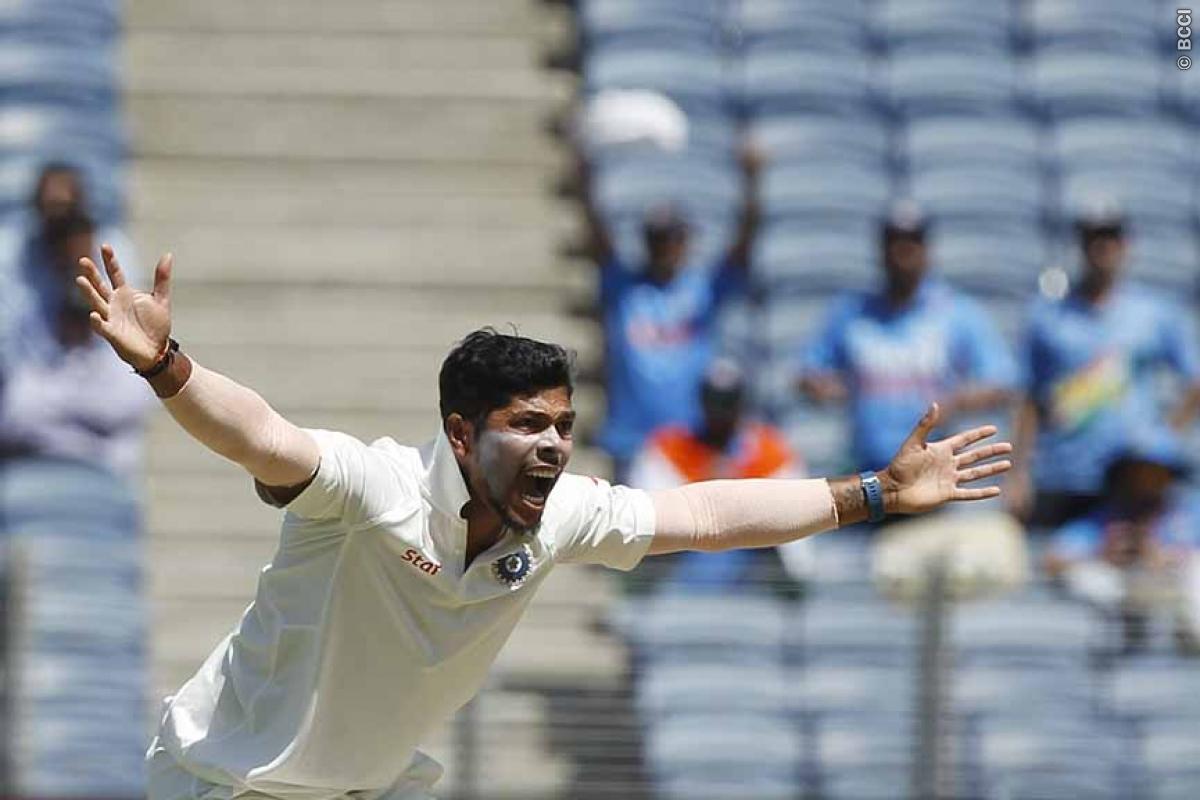Not compromising on pace no matter what: How Umesh Yadav braved all odds

BCCI
Former Australian pace bowler Glenn McGrath has applauded Indian bowler Umesh Yadav for his consistency and understanding of the workload management needed to sustain a fast bowling career. The boy from Deori endured a lot before making path-breaking progress in the international circuit.
Being a successful fast bowler is perhaps one of the most difficult tasks in cricket and achieving that feat in India, where people have always lionized their superstar batsmen, will be even more remarkable.
Despite the nation being home to some fine fast-bowling talents over the years, their consistency has been sporadic at best. In most cases, the express engines have fallen by the wayside, giving up on their pace in an attempt to prolong their career and thus achieving only occasional success in the international circuit.
Modern Indian cricket is littered with such examples- Munaf Patel, Irfan Pathan, VRV Singh, Varun Aaron, Ishant Sharma to some extent, and the list goes on. However, one player in recent times who has broken that grass ceiling is Umesh Yadav. Despite being pulled back by injuries and patchy form repeatedly, the boy from Nagpur has never really forgotten why he started playing the game and stuck to his USP, speed.
His perseverance and progress have earned him some a plethora of admirers that includes legendary Australian fast bowler, Glenn McGrath. “Umesh Yadav is bowling really well at the moment. He is up match after match. He is little bit older than what was a couple of years ago, he is also a lot more experienced...and he knows, (or) he should know, how to prepare himself, how to recover.”
McGrath was present at a two-day coaching session with the MRF Pace Foundation in Mumbai at the BKC indoor academy. Shedding some light on the current scenario, he said, “Everyone wants to bowl fast, I wanted to bowl fast, but no one is express… To bowl at 140-150 kmph is something very unique. It is a raw talent, you can’t teach that. Express bowlers are very rare and I’m always on the lookout for one. India is probably the toughest place in the world to be a fast bowler, but that plays a part. But, as I said, (bowling) 150 plus (kmph) is rare.”
The ‘rare’ Umesh Yadav was just another fast bowler when McGrath had first seen him back on India’s 2011-12 tour of Australia. What caught his attention was Yadav’s raw pace and adamant attitude. Though he kept deviating from his line and length often, MCG’s pitch favoured him tremendously and he ended up scalping seven wickets in what was only his third test.
India’s humiliating 4-0 defeat in that series did leave Yadav with a memory to cherish. At WACA in Perth, the pacer shocked Ricky Ponting with a stunning yorker that shattered the middle stump on his way to picking up a 5-wicket haul. The right-arm fast bowler from Vidarbha had ended that series with a 14-wicket haul at an average of 39.35, announcing his arrival.
But pace has been a gift given to many Indian bowlers and Yadav, although impressive, was lacking direction. What he terribly needed was someone who could give meaning to his raw pace. And before he could improve upon his craft, injuries crept in. It was during his impressive Test series with England in November 2012 that he experienced a stress reaction on his back.
Having fallen prey previously to a stress fracture Yadav was understandably more cautious this time, but not discouraged. Speaking to ESPNcricinfo back in 2013, he had said, “I had a stress fracture three years ago, but I bowled at the same pace when I came back. It's more a mindset. My mindset has always been to do what comes naturally to me. I am not going to change my natural pace.”
2013 remained a nightmarish season for the bowler as he got little chances to regain his lost stature. But he stuck to his words nonetheless, never letting go of his natural pace. When he returned in 2014, he had already made a name for himself in the longest format of the game but his lack of discipline was still a huge concern in the limited overs formats.
On wickets with good carry Yadav did pull off occasional unplayable deliveries, but his unruly bowling made him an expensive option. It left the captains quite annoyed and he was soon sidelined following the emergence of Mohammed Shami and Bhuvaneshwar Kumar as attacking options. However, the chief reason why he took so long in gaining prominence has been his sheer adamancy in not changing his bowling style.
IPL helped him a lot in these times. His raw talent finally received the much-needed guidance in Wasim Akram, Kolkata Knight Riders’ then bowling coach, after the side picked him up. Credits should be given to skipper Gautam Gambhir too, who decided to open their bowling with Yadav. KKR won the tournament that season.
A comfortable bowling action has been one of Yadav’s natural gifts. While the docile pitches in India have always overworked pacers to bring in that extra pace, Yadav’s short back-bend helped him get away with lesser workload. He had returned as a more polished threat, and was improving with every game.
The disarrayed balls were changing to a tighter line and the ‘just another fast bowler’ was gradually becoming unpleasant and unplayable for even the top batsmen. He hogged all the limelight in India’s five-match series against Sri Lanka that year. Yadav played a significant role in helping them seal a magnificent 5-0 whitewash by picking up 10 wickets.
His run-up had significantly changed over those past six months. His rickety wrist position had given way to a more controlled delivery that gifted him the ability of reverse swing. On Indian pitches, where Ravichandran Ashwin and Ravindra Jadeja were ruling, Yadav became capable of making the old ball both in-swing and out-wing with a pace hovering above 140 mph.
There was no stopping him then. Unlike Mahendra Singh Dhoni who favoured spinners, new captain Virat Kohli opted for an aggressive path going with a 6:5 (six batsmen and five bowlers) combination. Being selected in the squad for World Cup 2015, Yadav player took 18 wickets in eight, and ended third in the wicket-taking table to Australia’s Mitchell Starc and New Zealand’s Trent Boult, both of whom had taken 22 wickets.
The young skipper should be credited for Yadav’s achievements, who decided to use him more as a lethal weapon than a pillar for his spinners. Yadav’s progress knew no bounds now. He learnt to use the crease optimally. getting in different angles, taking the ball in and out as and when needed. The young and inexperienced youngster whose only weapon was to go through the stumps with his blistering pace was now making the batsman indecisive with his brilliance.
The body now obeying the mind, Umesh Yadav is capable of forcing batsmen into a decision with his majestic pace. Whether it’s a good-length ball, pressing at-the-batsman deliveries, patient fifth-stump spell or short-balls, the 29-year-old is capable of them all. And his scintillating displays in the Border-Gavaskar Trophy held earlier this year is a prime example of it.
While a naturally strong and muscular body type has helped him tremendously to prevent injuries, his growth into one of nation’s best fast bowlers should really be credited to him and him only. Despite him not being India’s leading wicket-taking bowler, his economy rate has improved massively over the years.
From the 2011-12 season, where he had bowled 151 overs getting 11 maidens and 16 wickets for 673 runs to last season, to now, where has bowled 238.5 overs getting 49 maidens and 15 wickets for 737 runs, there has been a massive improvement.
He has bowled numerous more overs compared to other Indian pacers and has remained without injury, which takes us back what McGrath states as the most quintessential aspect of a fast bowler’s career- ‘workload management’. Umesh Yadav has exhibited it brilliantly.
India had some really famous fast bowlers to their side in Kapil Dev, Chetan Sharma, Manoj Prabhakar, Javagal Srinath, Venkatesh Prasad and Zaheer Khan, to name a few. While they have had their moments, none could instil any kind of fast bowling aspirations among the next generation of budding cricketers. India has a really special thing going for them in the likes of Yadav and Shami, and there are strong probabilities that they will become role models for Gen Y.
